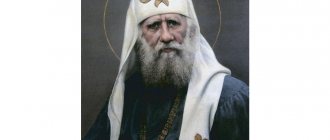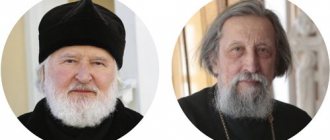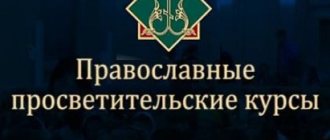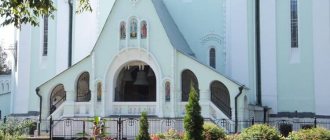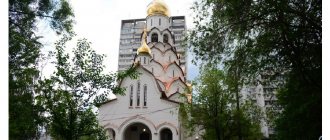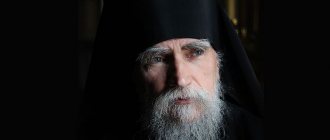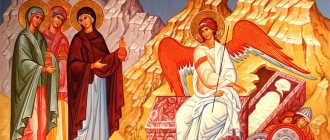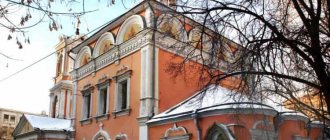Butovo training ground - Russian Golgotha
On February 24, RIA Novosti held a press conference “On the 100th anniversary of the feat of the new martyrs and confessors of the Russian Church during the confiscation of church valuables.”
The conference was attended by: the rector of the Church of the New Martyrs and Confessors of the Russian Church in Butovo, the executive secretary of the Church-Public Council under the Patriarch of Moscow and All Rus' for perpetuating the memory of the New Martyrs and Confessors of the Russian Church, Archpriest Kirill Kaleda; Professor of the Orthodox St. Tikhon's Humanitarian University, Candidate of Historical Sciences, priest Alexander Mazyrin; researcher at PSTGU, candidate of philosophical sciences, priest Sergius Ivanov; Deputy Chairman of the Synodal Department for Relations of the Church with Society and the Media V.V. Kipshidze; Corresponding Member of the Russian Academy of Sciences, Scientific Director of the State Archives of the Russian Federation, Doctor of Historical Sciences, Professor S.V. Mironenko; Director of the Memorial Scientific and Educational Historian I.V. Garkavy.
Participants in the press conference spoke about the feat accomplished by the faithful children of the Church, when in 1922 the Bolsheviks, in the form of helping the hungry, attempted to rob the Church, provoke confrontation between its hierarchy and the people, setting themselves the goal of the complete destruction of the Church as a spiritual space.
In his opening speech, V.V. Kipshidze emphasized: “We remember not so much how many valuables were confiscated from the Church, but what civil division and irrepressible hatred of brothers leads to.”
S.V. Mironenko said that the state archives contain a large number of documents relating to the relationship between the authorities and the Church, including documents of the 8th Liquidation Department of the People's Commissariat of Justice, so named because it was tasked with the liquidation of the Church. These documents testify to the deliberate persecution of the Church by the Bolshevik authorities and repressions against the clergy. Many of these documents have found their researchers, but there is a large volume of documents that need to be examined.
Priest Alexander Mazyrin said that the main task of the authorities was not to help the hungry, but to fight the Church. This thesis was convincingly proven by priest Sergius Ivanov, who for many years has been studying documents on the history of persecutions associated with the processes of confiscation of church values. Citing specific documented figures, Father Sergius showed that not a single penny received by the state as a result of these processes was spent on helping the hungry.
I.V. Garkavy in his speech quoted the words of V.I. Lenin from his letter to members of the Politburo, written during this anti-church campaign: “The more representatives of the reactionary clergy... we manage to shoot on this occasion, the better.”
Archpriest Kirill Kaleda told the audience about the events that, with the blessing of His Holiness Patriarch Kirill of Moscow and All Rus', are planned to be held in the coming year in memory of this page in the history of the Russian Church.
Patriarchy.ru
In war as in war
The Russian Church entered its way of the cross powerful and full-blooded: in 1914 in Russia there were 1,025 monasteries, 78,488 churches, chapels and prayer houses, 51,105 priests, 15,035 deacons and 46,489 clergy, 130 bishops. 70% of the empire's population - 120 million people - were considered Orthodox.
But in 1917, the Bolsheviks, having taken power, immediately waged a war of destruction against the Church. Already on November 2, the “Declaration of the Rights of the Peoples of Russia” expelled the Church from all spheres of civil and public life. And on December 11, all educational institutions were confiscated from her, overnight depriving her of the opportunity to train educated priests and engage in religious and moral education. On December 17–18, decrees on marriage legislation were adopted, according to which only civil marriage received legal force, on January 16, 1918, the institute of military priests was liquidated, on January 22, the decree “On Freedom of Conscience” was published, according to which religious societies were deprived of the right to own property and rights legal entity, on April 19, a special “liquidation” commission was created under the People’s Commissariat of Justice, and on July 10, the first Soviet constitution deprived the clergy and monastics of voting rights. Children of the clergy were also deprived of many rights (in particular, they were prohibited from entering higher educational institutions). Responsibility for parish life was assigned to a group of 20 laymen (“twenty”), which undermined the authority of the rector.
In 1918–1920, 673 monasteries out of 1025 pre-revolutionary monasteries were closed administratively.
|
Distant or close?
But in the consciousness of the early Church, the martyrs were not at all “victims” of bloody repressions on the part of godless persecutors: they were victors and gave birth not to pity and compassion, but to admiration for courage and fidelity to Christ.
But is this how we look at our new martyrs today? For some reason, we feel somehow awkward with them: in our minds we understand that they deserve great honor, but in practice we don’t really know what to do with their memory. They're kind of uncomfortable. Unformatted.
Or maybe we simply cannot break ties with the very “system of the world order” that our new martyrs resisted to the point of bloodshed - and defeated it? And their challenge is too harsh for our politically correct ears?
In order for us - not formally, but with all our hearts - to realize their holiness, it takes time and a real understanding that they prayerfully participate in our lives. Thank God, the saints - and especially the martyrs who endured such sorrows - know how to love us incomparably more than we know how to love and honor them. And they have a connection - lively and strong - with us.
First victims
The first Russian new martyr was Archpriest John Kochurov in 1917, who was killed by the Bolsheviks after the retreat of General Krasnov’s detachment from Tsarskoye Selo only because during a religious procession he tried to address the people with words of peace and consolation. And on January 25 (February 7, new style), 1918, revolutionary soldiers killed Metropolitan Vladimir in Kyiv, the first bishop to suffer martyrdom under Soviet rule.
During the civil war, the Cheka killed thousands of clergy and laity. The persecution of the Church in the press began. In 1922, the first public trial of the clergy took place - executions began “by court verdict.” In 1923 alone, 2,691 priests, 1,962 monks and 3,447 nuns and novices died.
Atheistic literature poured in: in the 15 years after the revolution, 1,700 titles of anti-religious literature were published with a total circulation of 40 million copies.
In 1928, the Church was declared a “kulak-NEPman agency” that “mobilizes reactionary and unconscious elements for the purpose of a counter-attack on the measures of Soviet power.” The authorities' intention to physically destroy representatives of religious consciousness became obvious. “Cult ministers” again began to be subjected to arrests, imprisonment, exile, and sometimes execution in large numbers. Between 1929 and 1933, about 40,000 clergy and clergy were repressed. As a rule, they were imprisoned “for anti-Soviet agitation” and “as a socially alien element.”
We don’t wash like that by skating
By the beginning of 1935, the number of registered clergy of the Russian Church did not exceed 20,000 people. Many went illegal.
And yet, in 1937, during the census, out of 98 million 400 thousand people over 16 years of age living in Soviet Russia, 41.6 million people called themselves Orthodox - 42.3% of the country's adult population. And a new wave of repression began. In 1937 alone, 60 bishops were shot. Ordinary clergy were also arrested en masse. Arbitrariness in persecution was elevated to the national level.
According to the Commission for the Rehabilitation of the Moscow Patriarchate, by 1941, 350 thousand people were repressed for their faith, of which 140 thousand were clergy. By 1941, there were 5,665 officially registered clergy in the Russian Church, and more than half of them lived in territories annexed to the USSR in 1939–1940. Religious life in the country outwardly almost ceased. But, despite the most terrible persecution in the history of Christianity, it was not possible to completely destroy the Church. And after the Great Patriotic War, the persecution of her resumed.
There is a youth discussion club at the parish. Meetings take place on Fridays at 18.00 once or twice a month. There we discuss issues of interest to young people, books, films, communicate, and get to know each other. Information by phone. 962267290.
Russian language
Every language is a door to a new world. We help children fall in love with their native language, master the norms of the literary language and Russian speech etiquette, and master reading and writing skills. Beautiful speech and competent writing are an achievable goal for bilingual children. We learn poems by Russian poets by heart, read books together and enjoy it.
Author's course "World culture and geography for children"
The author's course is designed so that children develop a harmonious and correct understanding of the spatial characteristics and cultural values of the world that surrounds them. Knowledge of how this world works gives a child the opportunity to quickly and correctly find his place in it.
The course is divided into 2 sections: “ancient civilizations” and “modern states”.
Each studied topic of the course is reinforced by students creating crafts related to the culture and life of a particular people.
art
The course is based on an academic approach to teaching such disciplines as “Drawing”, “Painting”, “Composition”. During the lessons, children get acquainted with the Russian classical artistic tradition, learn a variety of techniques and learn how to correctly use various materials: watercolor, gouache, pencils, pastels, acrylic, charcoal.
Sports ballroom dancing
The ability to control one’s own body is the basis for successful growing up. Sports ballroom dancing gives boys and girls not only the opportunity to move beautifully and fluidly, but also to feel involved in real art. A sense of rhythm, understanding of music, grace of movements and confidence in one’s body are not a complete list of the benefits that classes in a sports ballroom dance studio bring.
Literary and educational project “Reading Room”
The literary and educational project “Reading Room” was conceived and developed by the Child Development Center specifically to teach children to read thoughtfully. In form, these are reading lessons conducted on an ongoing basis, but in essence they are time and space completely devoted to the book. In these classes, it all starts with the teacher and students reading aloud together. And then - a free creative discussion and reflection on what was read, role-playing excerpts from the book, which makes it possible to get used to the images of the characters. This is followed by games specially prepared by the teacher, as well as creative and scientific experiments, selected so as to preserve the atmosphere of what they read and prolong the charm of the book for children.
Summer intensive courses and master classes led by specialists of various professions
We choose interesting, bright people, professionals, masters of their craft and invite them to our Center to conduct master classes with children. This allows you to make the training program more rich and varied.
For master classes that have the greatest success with Russian-speaking audiences, we develop a special program and create an intensive course, which we conduct during school holidays, and also create a series of master classes, ensuring their systematic implementation throughout the year. This allows students to master a skill that interests them in parallel with their main training.
This type of activity is constantly popular. Here is a far from complete list:
- culinary master classes with a pastry chef,
- master classes on creating bouquets with a professional florist,
- master classes “Physics in Experiments”,
- master classes with a photographer,
- series of master classes “Filming interviews”,
- series of master classes “Drawing with plasticine”,
- intensive course “Reading Russian”,
- summer intensive course “Drawing in nature”.
theatre studio
The theater studio of the Child Development Center has been operating since November 2016. During this time, six theatrical performances took place, attracting from 50 to 200 spectators.
Our theatrical musical productions provide the opportunity to bring talented children involved in various arts and sports from different cities of Portugal to the stage.
Child actors and child spectators are brought not only from Porto and its suburbs, but also from other cities in the north and center of Portugal: from Braga, Guimaraes, Aveiro, Santa Maria de Feira, Viseo, Coimbra, Viana de Castelo. These cities are located between 50 and 100 km from Porto.
During the existence of the theater studio, we presented the following productions:
— puppet theater “Teremok”;
— the performance “Pinocchio”, accompanied by dance and vocal numbers prepared under the guidance of a choreographer and vocalists who are teachers of our Center;
— a musical concert dedicated to the Day of Slavic Literature. (vocal and instrumental numbers performed by children were part of the general scenario about the emergence of the Slavic alphabet);
— literary and plastic production “Tsar Saltan”, organized jointly with the Committee for External Relations of the Government of St. Petersburg;
— theatrical musical production “Christmas Evening at the Christmas Tree.” The plot of the production is based on the story of a girl who, on a festive evening, receives guests who entertain her with Christmas musical numbers. The culmination of the holiday is a children's pantomime illustrating the recitation of S. Cherny's poem “Rozhdestvenskoe”;
— theatrical musical production “The Christmas Tree for Cinderella” is one of the latest and most popular performances, gathering more than 200 spectators in the hall and students from 4 Russian-language schools on the stage.
“We will show the last priest on TV!”
In 1945, the bells rang in the newly opened Trinity-Sergius Lavra, and in 1964 in the city of Veliky Ustyug, out of 40 pre-revolutionary churches, not a single one remained operational. “Churchmen” were now imprisoned and exiled for “parasitism,” “antisocial parasitic lifestyle,” and “unearned income.” However, there was an article for “violation of the laws on the separation of church and state,” and “anti-Soviet agitation and propaganda” has not been canceled.
Between 1961 and 1964, 1,234 people were convicted on religious grounds and sentenced to various terms of imprisonment and exile. In 1971, for the entire huge country, which occupied a sixth of the landmass, there were 6,234 priests and 618 deacons registered; the number of parishes decreased from 13,008 in 1960 to 7,338 in 1970. 32 Orthodox monasteries closed, leaving only 1,200 monastics throughout the country.

